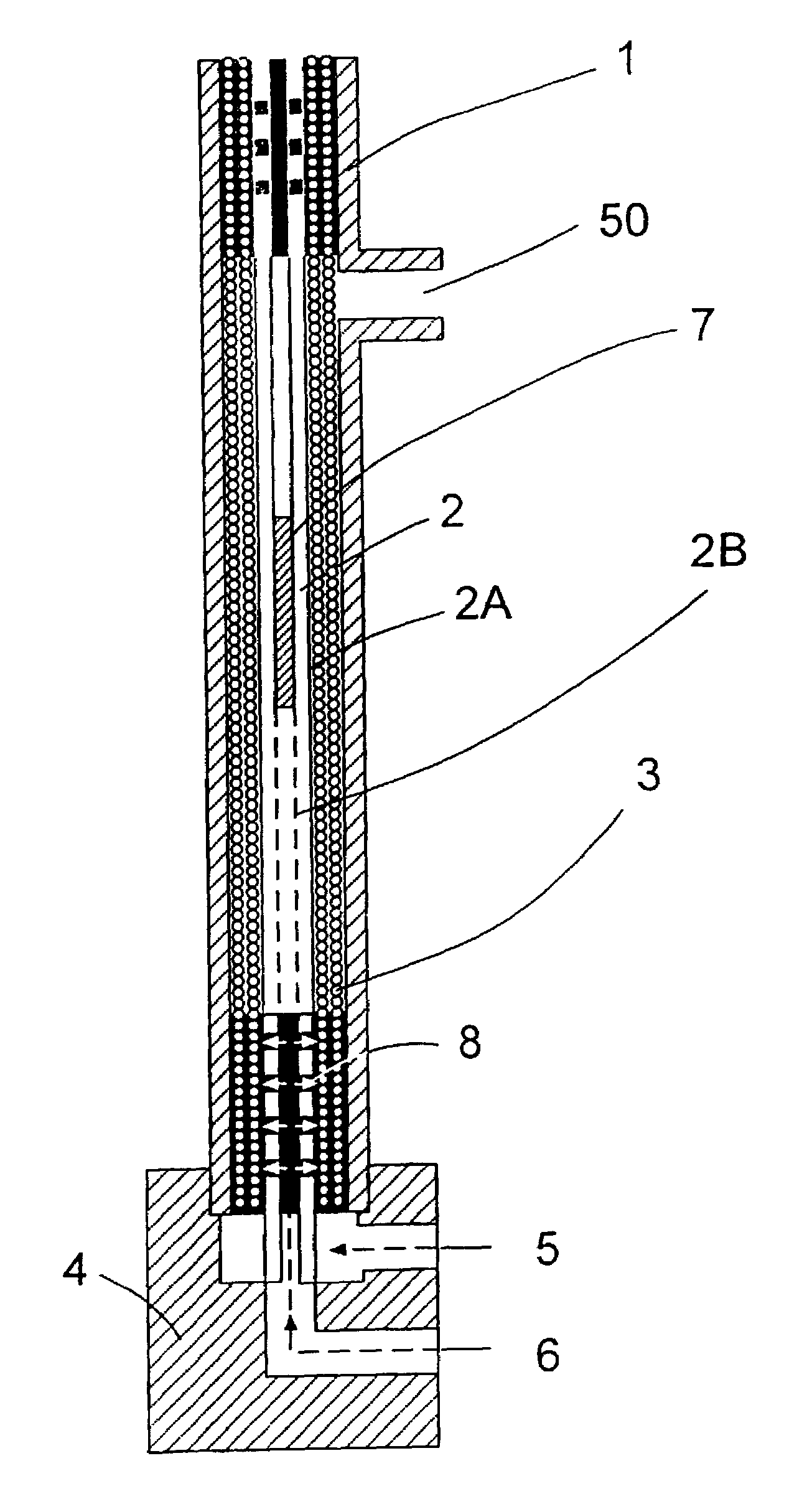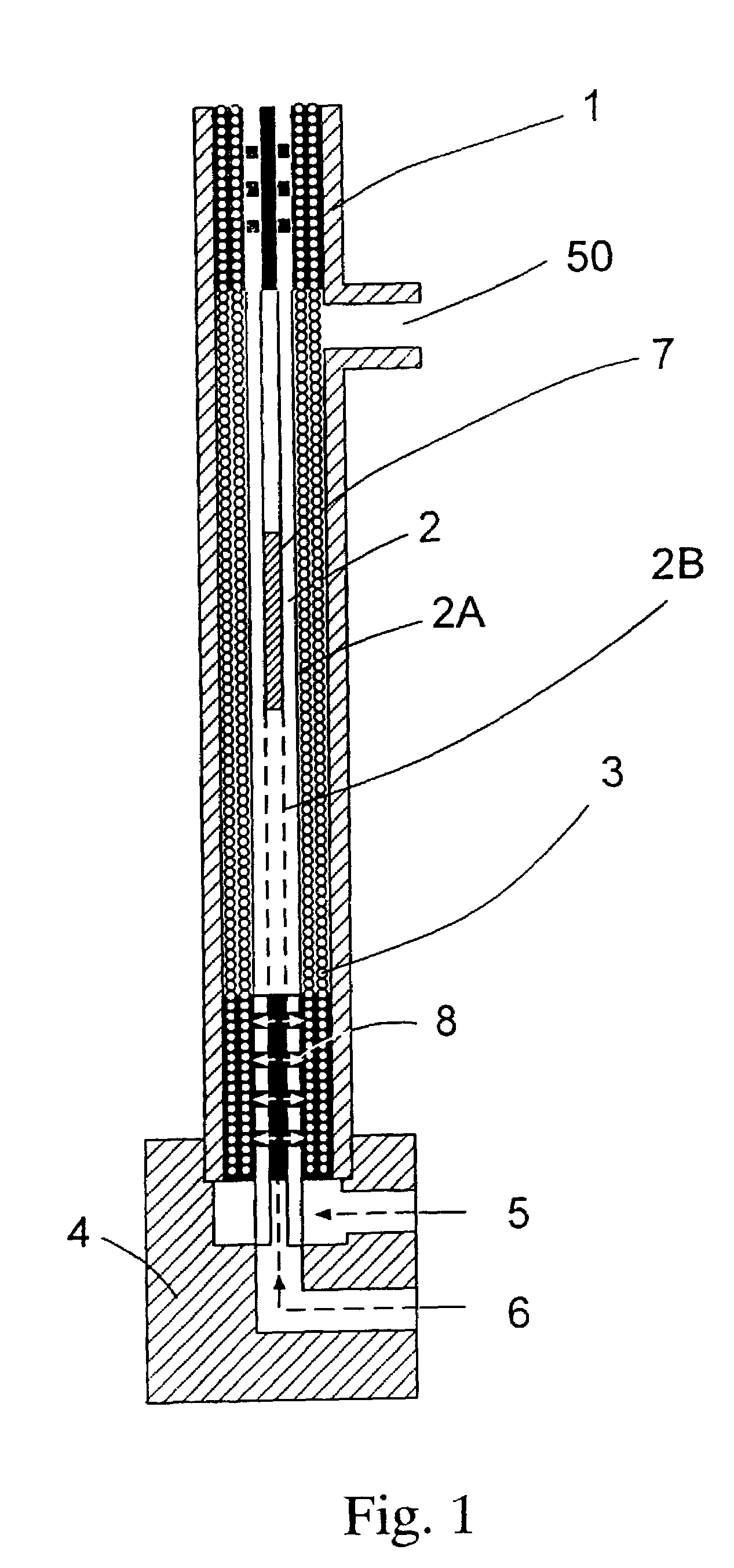Method for manufacturing a potted bundle of hollow fibers
a manufacturing method and technology of hollow fibers, applied in the field of manufacturing a potted bundle of hollow fibers, can solve the problems of mandrel interference with potting, inadequate coiled hollow fiber devices, and only recently disclosed coiled hollow fiber modules
- Summary
- Abstract
- Description
- Claims
- Application Information
AI Technical Summary
Benefits of technology
Problems solved by technology
Method used
Image
Examples
first embodiment
[0020]FIG. 1 illustrates the present invention. The shell or housing 1 contains a mandrel 2 having one or more layers of hollow fibers 3 wrapped around its outer surface 2A. This device is placed on a preformed block 4 that has an outer layer potting fill hole 5 and a center rod potting fill hole 6. The mandrel 2 as shown has a hollow center 2B and includes a plastic inset or plug 7 and through holes 8 in fluid communication with the inner layers of hollow fibers 3.
[0021]The structure is then inserted into the preformed block 4 and the inner layer fill hole 6 is then filled with enough potting compound such as epoxy to force the compound through the through holes 8 and into the fiber bundle to form a pot of predetermined height. The outer layer fill hole 5 is also filled with potting compound preferably to that same height. Preferably, the inner hole 6 is filled first followed by the outer hole 5 to ensure that adequate flow around all fibers is achieved. Alternatively, both may be ...
second embodiment
[0023]FIG. 2 shows the present invention. In this embodiment it is applied to straight hollow fibers. The shell or housing 10 contains a mandrel 11 having one or more layers of straight hollow fibers 12 surrounding the outer surface 13 of the mandrel 11. This device is placed on a preformed block 14 that has an outer layer potting fill hole 15 and a center rod potting fill hole 16. The mandrel 11 as shown has a hollow center 17 and includes a plastic inset or plug 18 and through holes 19 in fluid communication with the inner layers of hollow fibers 12.
[0024]Potting compound such as epoxy or urethane resin is then flowed into the inner layer fill hole 16 with enough potting compound to force the compound through the through holes 19 and into the fiber bundle to form a pot of predetermined height. The outer layer fill hole 15 is also filled with potting compound preferably to that same height. Preferably, the inner hole 16 is filled first followed by the outer hole 15 to ensure that a...
third embodiment
[0025]FIG. 3 shows the present invention. In this embodiment it is applied to straight hollow fibers. The shell or housing 20 contains two short mandrels 21A and B that are equal in length or slightly longer than the area or length of fiber which will be potted. Each mandrel 21A and 21B is located at opposite ends of the shell 20 and have one or more layers of straight hollow fibers 22 surrounding the outer surface 23A and 23B respectively of each mandrel 21A and 21B. This device is placed on a preformed block 24 that has an outer layer potting fill hole 25 and a center rod potting fill hole 26. The mandrels 21A and B as shown each has a hollow center 27 and includes an end cap 28A and 28B and through holes 29A and B in fluid communication with the inner layers of hollow fibers 22.
[0026]Potting compound such as epoxy or urethane resin is then flowed into the inner layer fill hole 26 with enough potting compound to force the compound through the through holes 29A and B and into the f...
PUM
| Property | Measurement | Unit |
|---|---|---|
| length | aaaaa | aaaaa |
| height | aaaaa | aaaaa |
| wetting | aaaaa | aaaaa |
Abstract
Description
Claims
Application Information
 Login to View More
Login to View More - R&D
- Intellectual Property
- Life Sciences
- Materials
- Tech Scout
- Unparalleled Data Quality
- Higher Quality Content
- 60% Fewer Hallucinations
Browse by: Latest US Patents, China's latest patents, Technical Efficacy Thesaurus, Application Domain, Technology Topic, Popular Technical Reports.
© 2025 PatSnap. All rights reserved.Legal|Privacy policy|Modern Slavery Act Transparency Statement|Sitemap|About US| Contact US: help@patsnap.com



